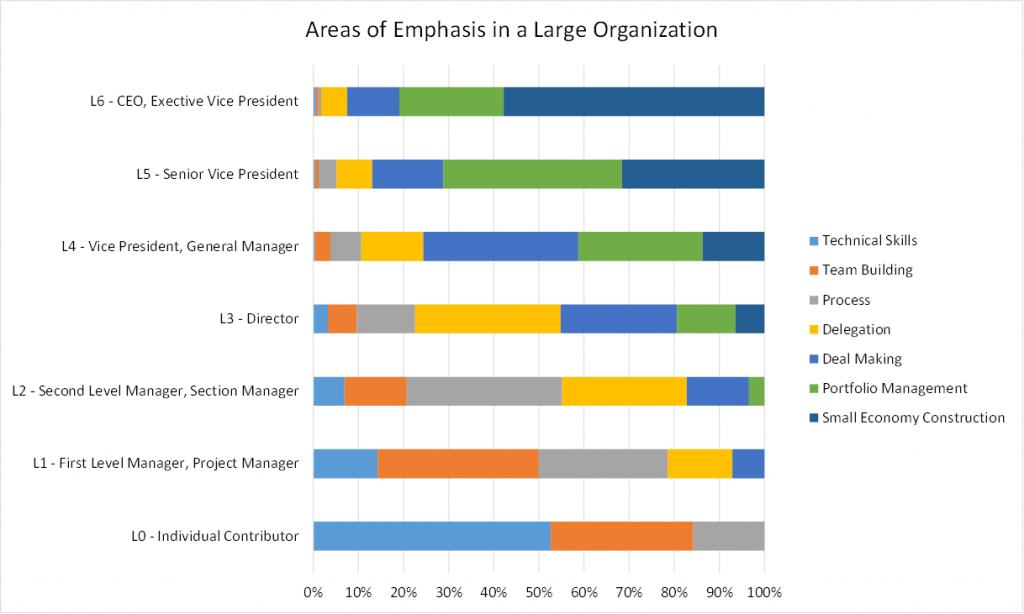I work in a giant corporation that’s nominally organized in the usual military model hierarchy. Yes, there are lots of subtleties, variations, and experiments (matrix management – gag, two in a box, self managed teams, etc.), but this has been the dominant model for as long as I’ve been there. I’ve spent a lot of years trying to sort through what I should be expecting from whom in each layer of management and I think I’ve finally come up with a model that works for me. I’d like to share it with you.
This is my “Areas of Emphasis” model and it describes where you put, or should be putting, most of your attention depending on where you’re at in an organizational hierarchy.
The model crosses seven layers of management with seven areas of emphasis. An area of emphasis is where a person at that level spends most of their time, focus and energy. There are a few general principles embodied in the model. These include…
- Advancement – After doing the job that you’re supposed to be doing, you spend the most amount of the rest of your energy learning how to do the job at the next layer up in the hierarchy.
- Don’t look back – As you move up the hierarchy, you hire people to do the job you just left. As a result your attention to these matters drops sharply and is primarily composed of oversight and guidance. The alternative is micromanagement.
- Appreciation – No matter where you’re at in the hierarchy you must maintain enough knowledge and understanding of the other areas of emphasis to relate effectively to those who focus on those areas.
Individual Contributors primarily focus on Technical Skills – This group refers to what’s often referred to as the “rank and file” (again another military allusion). These are not staff positions, which make different kinds of contributions depending on the level of the manager that you’re working for. Individual contributors spend the bulk of their time focusing on delivering the technical skills that are required to make the organization effective. “Technical” in this sense is defined broadly and can range from the ability to lift heavy things to modifying the genetic structure of arcane viruses. To cite too many metaphors, this is where “the rubber meets the road”. It’s the organization’s contact point with the physical and economical world. Without these folks the organization would be an abstract entity and fairly pointless. Beyond the contributions of their technical skill they will also spend a lot of time on team building and a fair amount on process.
First Level Managers primarily focus on Team Building – It’s often observed that the best first level managers have a strong working appreciation of the skills of those who work for them. It’s also true that the definition of a knowledge working is someone who knows more than their boss (I think it was Peter Druker who said something like this). A first level manager’s emphasis moves away from technical skills and focuses on team building. Insuring that the team has the right arrangement of skills and that the team produces effectively together and works well within the larger system.
Second Level Managers primarily focus on Process – Second level management is the first layer where managers manage other managers. It begins the process of abstracting away individuals in favor of a self sustaining organization. This is primarily accomplished through the creation and management of processes. These are behavioral structures that are independent of the individuals performing them. As individuals come and go and teams come and go the processes live on and begin to give the organization a life of its own.
Third Level Managers, Directors, focus on Delegation – Third level management is the first layer that provides the organization with meaning. The primary emphasis of their position is to clearly define and to clearly delegate the objectives that the organization can be applied to. A key element is crafting the vision of what the organization is to become and to be known for. This vision is decomposed into tasks that can be accomplished by the processes and individuals in the organization whatever the purpose of the moment happens to be.
Vice Presidents focus on Deal Making – Vice presidents create opportunities that the organization can act on. They have the authority and responsibility to seek out these opportunities and to make the deals that provide the organization with purpose. Their contribution to the vision is to describe how the world will be changed because the organization exists and chooses to act and less about what the organization will be.
Senior Vice Presidents focus on Portfolio Management – Senior vice presidents spend their time trading off the opportunities that the vice presidents bring to the table with the purpose of optimizing investments and portfolio value. They tend to have less influence on any particular vision and more focus on the key measured outcomes of the larger organization as a whole.
CEOs and Executive Vice Presidents manage Small Economies – A very large organization has many, hopefully complementary, moving parts. Each of these parts tends to be a portfolio of initiatives and objectives. For the larger organization to be successful these parts need to operate synergistically. The knobs at this level tend to be belief systems, reward systems, redistribution of investments, establishing key organization wide metrics and other mechanisms often attributed to governments and their management of larger economies. It is very much a social engineering activity.
In my position, a member of staff for a director, I can find myself interacting with people in each of these layers at any given moment. This model helps me to understand what they’re likely to be caring about. It also helps me to evaluate what’s working and what’s dysfunctional in various parts of the organization. Sometimes it helps. Sometimes it just makes me frustrated.





